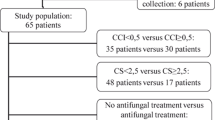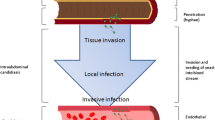Abstract
Clinical severity of invasive candidiasis in critically ill patients and existing difficulties in timely diagnosis mean that early empirical therapy, based upon a strict clinical and epidemiological judgement, is required in intensive care unit patients. One school of thought is that the clinical severity and epidemiological burden of this disease warrant prophylaxis in all critically ill patients. In reality, however, there are still many open-ended questions with regard to which variables are most apt for selection of patients requiring prophylactic or empirical treatment. As a consequence of a consistently significant correlation between colonization (one or more Candida-positive cultures from non-sterile sites) and subsequent infection, colonization remains the most universally accepted predictive variable with regard to invasive candidiasis. This is particularly true for high density colonization. It has not yet been clarified whether colonization can be used in isolation to identify high-risk patients or if it should be combined with other variables indicating high risk. Additionally, there is still a debate surrounding the question as to whether determination of multisite colonization is required, or whether detecting colonization at one or two specific sites is sufficient for the identification of high-risk patients. From a practical perspective, candiduria (a frequent finding in critically ill patients) appears one of the most promising parameters with regard to single-site assessment, owing to easy sampling procedures. Definitive evidence of a correlation between candiduria and invasive candidiasis is currently still lacking, as the few published studies thus far have yielded conflicting results. It is, however, apparent that candiduria can be reliably considered a surrogate marker of high density of colonization, thereby potentially representing a more practical, less resource-intensive screening marker of heavy colonization and high risk of infection than is currently possible using parameters such as the multiple-site colonization index.
Similar content being viewed by others
References
Ellis M. Invasive fungal infections: evolving challenges for diagnosis and treatment. Mol Immunol 2001; 28: 947–57
Guery BP, Arendrup MC, Auzinger G, et al. Management of invasive candidiasis and candidemia in adult non-neutropenic intensive care unit patients: part I. Epidemiology and Diagnosis Intensive Care Med 2009; 35: 55–62
McMullan R, Metwally L, Coyle PV, et al. A prospective clinical trial of a real-time polymerase chain reaction assay for the diagnosis of candidemia in nonneutropenic, critically ill adults. Clin Infect Dis 2008; 46: 890–6
Schuster MG, Edwards Jr JE, Sobel JD, et al. Empirical fluconazole versus placebo for intensive care unit patients: a randomized trial. Ann Intern Med 2008; 149: 83–90
Morrell M, Fraser VJ, Kollef MH. Delaying the empiric treatment of Candida bloodstream infection until positive blood culture results are obtained: a potential risk factor for hospital mortality. Antimicrob Agents Chemother 2005; 49: 3640–5
Garey KW, Rege M, Pai MP, et al. Time to initiation of fluconazole therapy impacts mortality in patients with candidemia: a multi-institutional study. Clin Infect Dis 2006; 43: 25–31
Parkins MD, Sabuda DM, Elsayed S, et al. Adequacy of empirical antifungal therapy and effect on outcome among patients with invasive Candida species infections. J Antimicrob Chemother 2007; 60: 613–8
Blot SI, Vandewoude KH, Hoste EA, et al. Effects of nosocomial candidemia on outcomes of critically ill patients. Am J Med 2002; 113:480–5
Ables AZ, Blumer NA, Valainis GT, et al. Fluconazole prophylaxis of severe Candida infections in trauma and postsurgical patients: Prospective, double blind, randomised, placebo controlled trial. Infect Dis Clin Pract 2000; 9: 169–75
Pelz RK, Hendrix CW, Swoboda SM, et al. Double-blind placebo-controlled trial of fluconazole to prevent candidal infections in critically ill surgical patients. Ann Surg 2001; 233: 542–8
Playford EG, Webster AC, Sorrell TC, et al. Antifungal agents for preventing fungal infections in non-neutropenic critically ill patients. Cochrane Database Syst Rev 2006; 1: CD004920
Schelenz S. Management of candidiasis in the intensive care unit. J Antimicrob Chemother 2008; 61 Suppl. 1: i31–4
Ostrosky-Zeichner L, Sable C, Sobel J, et al. Multicenter retrospective development and validation of a clinical prediction rule for nosocomial invasive candidiasis in the intensive care setting. Eur J Clin Microbiol Infect Dis 2007; 26: 271–6
Blumberg HM, Jarvis WR, Soucie JM, et al. Risk factors for candidal bloodstream infections in surgical intensive care unit patients: the NEMIS prospective multicenter study. The National Epidemiology of Mycosis Survey. Clin Infect Dis 2001; 33: 177–86
Pittet D, Monod M, Suter PM, et al. Candida colonization and subsequent infections in critically ill surgical patients. Ann Surg 1994; 220: 751–8
McKinnon PS, Goff DA, Kern JW, et al. Temporal assessment of Candida risk factors in the surgical intensive care unit. Arch Surg 2001; 136: 1401–8
Al-Tawfiq JA. Distribution and epidemiology of Candida species causing fungemia at a Saudi Arabian hospital, 1996–2004. Int J Infect Dis 2007; 11: 239–44
Jordà-Marcos R, Alvarez-Lerma F, Jurado M, et al. Risk factors for candidaemia in critically ill patients: a prospective surveillance study. Mycoses 2007; 50: 302–10
Leon C, Ruiz-Santana S, Saavedra P, et al. A bedside scoring system (‘Candida score’) for early antifungal treatment in nonneutropenic critically ill patients with Candida colonization. Crit Care Med 2006; 34: 730–7
Agvald-Ohman C, Klingspor L, Hjelmqvist H, et al. Invasive candidiasis in long-term patients at a multidisciplinary intensive care unit: Candida colonization index, risk factors, treatment and outcome. Scand J Infect Dis 2008; 40:145–53
Piarroux R, Grenouillet F, Balvay P, et al. Assessment of preemptive treatment to prevent severe candidiasis in critically ill surgical patients. Crit Care Med 2004; 32: 2443–9
Tsuruta R, Mizuno H, Kaneko T, et al. Preemptive therapy in non-neutropenic patients with Candida infection using the Japanese guidelines. Ann Pharmacother 2007; 41: 1137–43
Sandven P, Qvist H, Skovlund E, et al. Significance of Candida recovered from intraoperative specimens in patients with intra-abdominal perforations. Crit Care Med 2002; 30: 541–7
Montravers P, Dupont H, Gauzit R, et al. Candida as a risk factor for mortality in peritonitis. Crit Care Med 2006; 34: 646–52
el-Ebiary M, Torres A, Fabregas N, et al. Significance of the isolation of Candida species from respiratory samples in critically ill, non-neutropenic patients: an immediate postmortem histologic study. Am J Respir Crit Care Med 1997; 156: 583–90
Rello J, Esandi ME, Diaz E, et al. The role of Candida sp isolated from bronchoscopic samples in nonneutropenic patients. Chest 1998; 114: 146–9
Azoulay E, Timsit JF, Tafflet M, et al. Candida colonization of the respiratory tract and subsequent Pseudomonas ventilator-associated pneumonia. Chest 2006; 129: 110–7
Delisle MS, David R, Williamson DR, et al. The clinical significance of Candida colonization of respiratory tract secretions in critically ill patients. J Critical Care 2008; 23: 11–7
Magill S, Swoboda SM, Johnson EA, et al. The association between anatomic site of Candida colonization, invasive candidiasis, and mortality in critically ill surgical patients. Diagnost Microbiol Infect Dis 2006; 55: 293–301
Ang BSP, Telenti A, King B, et al. Candidemia from a urinary tract source: microbiological aspects and clinical significance. Clin Infect Dis 1993; 17: 662–6
Dyess DL, Garrison RN, Fry DE. Candida sepsis: implications of polymicrobial bloodborne infection. Arch Surg 1985; 120: 345–8
Alvarez-Lerma F, Nolla-Salas J, Leon C, et al. Candiduria in critically ill patients admitted to intensive care medical units. Intensive Care Med 2003; 29: 1069–76
Binelli CA, Moretti ML, Assis RS, et al. Investigation of the possible association between nosocomial candiduria and candidaemia. Clin Microbiol Infect 2006; 12: 538–43
Charles PE, Dalle F, Aube H, et al. Candida spp. colonization significance in critically ill medical patients: a prospective study. Intensive Care Med 2005; 31: 393–400
Chabasse D. Interest of yeast numeration in urine. Review of literature and preliminary results of a multicentric prospective study carried out in 15 hospital centers. Ann Fr Anesth Reanim 2001; 20: 400–6
Sellami A, Sellami H, Makni F, et al. Candiduria in intensive care unit: significance and value of yeast numeration in urine. Ann Fr Anesth Reanim 2006; 25: 584–88
Toya SP, Schraufnagel DE, Tzelepis GE. Candiduria in intensive care units: association with heavy colonization and candidaemia. J Hosp Infect 2007; 66: 201-6
Acknowledgements
The author thanks Joanne Dalton of Wolters Kluwer Pharma Solutions who provided assistance with English language editing. This assistance was funded by Pfizer.
The author has served as an advisor to, and received honoraria and research grants from Pfizer Pharmaceuticals, has received honoraria from Merck Sharp & Dohme, Schering Plough and Gilead, and has served as a consultant to Astellas.
Author information
Authors and Affiliations
Corresponding author
Rights and permissions
About this article
Cite this article
Viale, P. Candida Colonization and Candiduria in Critically Ill Patients in the Intensive Care Unit. Drugs 69 (Suppl 1), 51–57 (2009). https://doi.org/10.2165/11315640-000000000-00000
Published:
Issue Date:
DOI: https://doi.org/10.2165/11315640-000000000-00000




